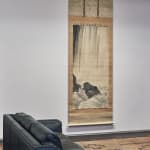Maruyama Ōkyo (1733–1795)
Waterfall
Ink and light color on silk, hanging scroll
1774
With note of authenticity by Imaizumi Yusaku and Maruyama Osho respectively, box authentication by Maruyama Osho, double boxed
Seals: Okyo no in; Chusen
173 x 81 cm
272 x 100 cm (overall)
1774
With note of authenticity by Imaizumi Yusaku and Maruyama Osho respectively, box authentication by Maruyama Osho, double boxed
Seals: Okyo no in; Chusen
173 x 81 cm
272 x 100 cm (overall)
Further images
Exhibitions
Bo-kyuka zohin nyusatsu. Tokyo: Tokyo Art Club, 1919.Literature
Sasaki Johei and Sasaki Masako. A Study of Maruyama Okyo. Tokyo: Chuokoron Bijutsu Shuppan, 1996.Minamoto Toyomune et al, eds. Maruyama Okyo. Kyoto: The Kyoto Shimbun, 1999.
Maruyama Okyo was a stylistic innovator in many respects, including the representation of water. The Confucian scholar and seal engraver Ko Fuyo in 1778 provided a poetic inscription to one of Okyo’s paintings, Blossom Viewing in the Land of Immortals, remarking “How beautiful his water is! Sometimes it streams slowly as if waiting for something, but in other works he suddenly lets the roaring torrents collapse.” The former refers to works such as Okyo’s carp paintings, that emphasize slow movement. In such paintings, the artist would often use an elevated point of view, creating an impression as if the viewer gazes into the water from above. Okyo’s approach produced works that appeared more lifelike than anything that ever before had been attempted in Japanese or even Chinese and Korean painting. The latter remark by Ko Fuyo refers to paintings like the present Waterfall. Traditionally, artists have painted waterfalls by arranging undulating lines, one next to the other, often with limited success in expressing the true kinetic forces at work. In this painting, broad ink lines and washes concentrate in the upper left, gradually fading out in the center of the picture. By leaving the areas blank where the water reaches the bottom of fall, Okyo creates the impression of intense motion, a collision of energies too powerful for the brush to capture.
Okyo also experimented with the shapes and textures of rocks. Around 1774, he painted several works with waterfalls. The most famous among them is Great Waterfall (1772) in the collection of the Shokokuji temple, a commission by Prince Abbot Yujo of the Enman’in temple (Otsu), Okyo’s most important patron in the late 1760s to early 1770s. Here, the artist employed countless texture strokes (shun) to have the rocks appear rugged. Two years later in the present work, such texture strokes are mostly omitted. Okyo’s technique of ink shading is different from tarashikomi, a technique associated with the Rimpa school. Yet, to show the volume of the rocks the painter relies fully on ink shades and gradations. Okyo used this technique again in color in the rocks of his sliding door painting Guo Ziyi in the Daijoji temple, an effect comparable to Western chiaroscuro.
According to Banshi, the diary of the abovementioned Yujo, Okyo would emphasize that to create a beautiful shading one has to be cautious not to use too many outlines. Chiaroscuro and elimination of outlines are two essential elements of naturalism in the Italian Renaissance. Of course, Okyo’s achievements are difficult to compare here, but some of his art clearly aimed into a similar direction. Verisimilitude to nature in art indeed is a universal problem.
Maruyama Okyo (painter; 1733–1795)
Painter from Tamba Province (near Kyoto). Okyo moved to Kyoto in his youth and studied with the Kano master Ishida Yutei. During the 1760s, under the patronage of Prince Abbot Yujo of the temple Enman’in (Otsu, now Shiga Prefecture), Okyo studied Song and Yuan painting, Rimpa and immersed himself in sketching from life (shasei). The resulting synthesis provided the basis for the Maruyama-Shijo school, founded by Okyo. He is known for his many disciples, including Nagasawa Rosetsu and Goshun, who came to dominate painting in Kyoto at the turn of the nineteenth century.
Okyo also experimented with the shapes and textures of rocks. Around 1774, he painted several works with waterfalls. The most famous among them is Great Waterfall (1772) in the collection of the Shokokuji temple, a commission by Prince Abbot Yujo of the Enman’in temple (Otsu), Okyo’s most important patron in the late 1760s to early 1770s. Here, the artist employed countless texture strokes (shun) to have the rocks appear rugged. Two years later in the present work, such texture strokes are mostly omitted. Okyo’s technique of ink shading is different from tarashikomi, a technique associated with the Rimpa school. Yet, to show the volume of the rocks the painter relies fully on ink shades and gradations. Okyo used this technique again in color in the rocks of his sliding door painting Guo Ziyi in the Daijoji temple, an effect comparable to Western chiaroscuro.
According to Banshi, the diary of the abovementioned Yujo, Okyo would emphasize that to create a beautiful shading one has to be cautious not to use too many outlines. Chiaroscuro and elimination of outlines are two essential elements of naturalism in the Italian Renaissance. Of course, Okyo’s achievements are difficult to compare here, but some of his art clearly aimed into a similar direction. Verisimilitude to nature in art indeed is a universal problem.
Maruyama Okyo (painter; 1733–1795)
Painter from Tamba Province (near Kyoto). Okyo moved to Kyoto in his youth and studied with the Kano master Ishida Yutei. During the 1760s, under the patronage of Prince Abbot Yujo of the temple Enman’in (Otsu, now Shiga Prefecture), Okyo studied Song and Yuan painting, Rimpa and immersed himself in sketching from life (shasei). The resulting synthesis provided the basis for the Maruyama-Shijo school, founded by Okyo. He is known for his many disciples, including Nagasawa Rosetsu and Goshun, who came to dominate painting in Kyoto at the turn of the nineteenth century.









